
The third US ship to be named Enterprise was a schooner, built by Henry Spencer at Baltimore, Maryland, in 1799. Her first commander thought that she was too lightly built and that her quarters, in particular, should be bulletproofed. Enterprise was overhauled and rebuilt several times, effectively changing from a twelve-gun schooner to a fourteen-gun topsail schooner and eventually to a brig. Enterprise saw action in the Caribbean, the Mediterranean, and the Caribbean again, capturing numerous prizes. She wrecked in July 1823.
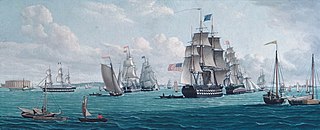
USS Franklin of the United States Navy was a 74-gun ship of the line.
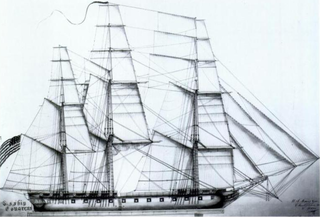
USS Congress was a nominally rated 38-gun wooden-hulled, three-masted heavy frigate of the United States Navy. James Hackett built her in Portsmouth New Hampshire and she was launched on 15 August 1799. She was one of the original six frigates whose construction the Naval Act of 1794 had authorized. The name "Congress" was among ten names submitted to President George Washington by Secretary of War Timothy Pickering in March of 1795 for the frigates that were to be constructed.Joshua Humphreys designed these frigates to be the young Navy's capital ships, and so Congress and her sisters were larger and more heavily armed and built than the standard frigates of the period.

The First Barbary War (1801–1805), also known as the Tripolitan War and the Barbary Coast War, was the first of two Barbary Wars, in which the United States and Sweden fought against the four North African states known collectively as the "Barbary States".
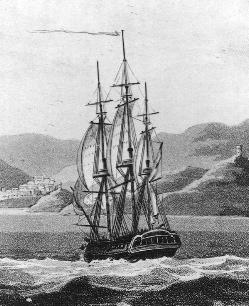
USS Philadelphia, a 1240-ton, 36-gun sailing frigate, was the second vessel of the United States Navy to be named for the city of Philadelphia. Originally named City of Philadelphia, she was built in 1798–1799 for the United States government by the citizens of that city. Funding for her construction was the result of a funding drive which raised $100,000 in one week, in June 1798. She was designed by Josiah Fox and built by Samuel Humphreys, Nathaniel Hutton and John Delavue. Her carved work was done by William Rush of Philadelphia. She was laid down about November 14, 1798, launched on November 28, 1799, and commissioned on April 5, 1800, with Captain Stephen Decatur, Sr. in command. She was captured in Tripoli with William Bainbridge in command, and perhaps best remembered for a raid led by Stephen Decatur that burned her down.

Edward Preble was a United States naval officer who served with great distinction during the 1st Barbary War, leading American attacks on the city of Tripoli and forming the officer corps that would later lead the U.S. Navy in the War of 1812.

Charles Stewart was an officer in the United States Navy who commanded a number of US Navy ships, including USS Constitution. He saw service during the Quasi War and both Barbary Wars in the Mediterranean along North Africa and the War of 1812. He later commanded the navy yard in Philadelphia and was promoted to become the Navy's first flag officer shortly before retiring. He was promoted to rear admiral after he retired from the Navy. He lived a long life and was the last surviving Navy captain who had served in the War of 1812.
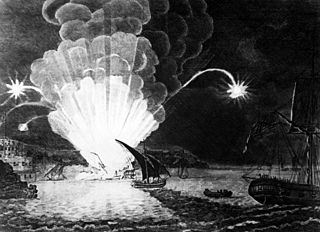
The first USS Intrepid was a captured ketch in the United States Navy during the First Barbary War.

The first USS Argus, originally named USS Merrimack, was a brig in the United States Navy commissioned in 1803. She enforced the Embargo Act of 1807 and fought in the First Barbary War – taking part in the blockade of Tripoli and the capture of Derna – and the War of 1812. During the latter conflict, she had been audaciously raiding British merchant shipping in British home waters for a month, when the heavier British Cruizer-class brig-sloopHMS Pelican intercepted her. After a sharp fight during which Argus's captain, Master Commandant William Henry Allen, was mortally wounded, Argus surrendered when the crew of Pelican were about to board.

USS Syren was a brig of the United States Navy built at Philadelphia in 1803. She served during the First Barbary War and the War of 1812 until the Royal Navy captured her in 1814. The British never commissioned her but apparently used her for a year or so as a lazaretto, or a prison vessel. She then disappears from records.
Joseph Tarbell was an officer in the United States Navy during the First Barbary War and the War of 1812.

Commodore Jacob Nicholas Jones was an officer in the United States Navy during the Quasi-War with France, the First Barbary War and the Second Barbary War, and the War of 1812.

Nautilus was a schooner launched in 1799. The United States Navy purchased her in May 1803 and commissioned her USS Nautilus; she thus became the first ship to bear that name. She served in the First Barbary War. She was altered to a brigantine. The British captured Nautilus early in the War of 1812 and renamed her HMS Emulous. After her service with the Royal Navy, the Admiralty sold her in 1817.
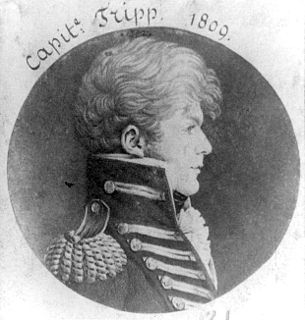
John Trippe was an officer in the United States Navy during the Quasi-War with France and the First Barbary War.

USS Vixen was a schooner in the United States Navy during the First Barbary War. Vixen was one of four vessels authorized by Congress on 28 February 1803. She was built at Baltimore, Maryland, in the spring of 1803; and launched on 25 June, Lieutenant John Smith in command.

The Mediterranean Squadron, also known as the Mediterranean Station, was part of the United States Navy in the 19th century that operated in the Mediterranean Sea. It was formed in response to the First and Second Barbary Wars. Between 1801 and 1818, the squadron was composed of a series of rotating squadrons. Later, squadrons were sent in the 1820s to the 1860s to suppress piracy, primarily in Greece and to engage in gunboat diplomacy. In 1865 the force was renamed the European Squadron.

The Second Battle of Tripoli Harbor was a naval action that occurred during the American naval blockade which took place in Tripoli Harbor on July 14, 1804. The battle was part of the First Barbary War between forces of the United States and the forces of the Eyalet of Tripolitania.
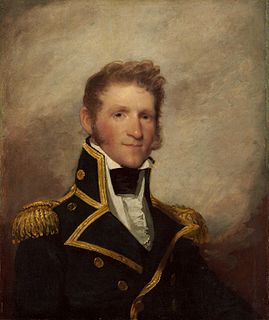
Thomas Macdonough, Jr. was an early-19th-century Irish-American naval officer noted for his roles in the first Barbary War and the War of 1812. He was the son of a revolutionary officer, Thomas Macdonough, Sr. who lived near Middletown, Delaware. He was the sixth child from a family of ten siblings and was raised in the countryside. He entered naval life at an early age, receiving a midshipman's commission at the age of sixteen. Serving with Stephen Decatur at Tripoli, he was a member of "Preble's Boys", a select group of U.S. naval officers who served under the command of Commodore Preble during the First Barbary War. Macdonough achieved fame during the War of 1812, commanding the American naval forces that defeated the British navy at the Battle of Lake Champlain, part of the larger Battle of Plattsburgh, which helped lead to an end to that war.

Stephen Decatur Jr. was an American naval officer and commodore. He was born on the eastern shore of Maryland in Worcester County. His father, Stephen Decatur Sr., was a commodore in the United States Navy who served during the American Revolution; he brought the younger Stephen into the world of ships and sailing early on. Shortly after attending college, Decatur followed in his father's footsteps and joined the U.S. Navy at the age of nineteen as a midshipman.

















